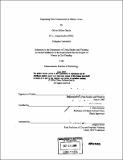Regulating new construction in historic areas
Author(s)
Sellers-Garcia, Oliver
DownloadFull printable version (34.05Mb)
Other Contributors
Massachusetts Institute of Technology. Dept. of Urban Studies and Planning.
Advisor
J. Mark Schuster.
Terms of use
Metadata
Show full item recordAbstract
This study is an examination of how the restrictiveness of different design regulations impacts the process of new construction in historic areas. The North End, South End, and Back Bay neighborhoods of Boston were identified as historic areas that possessed increasingly restrictive design regulations, and within each neighborhood, two recent new buildings were selected as case studies. Each pair of cases represented a project that had undergone either an easy or difficult approval process under the district's design regulations. Using relevant statutes, interviews with regulators, reviewers, and architects, and the official documentation produced during the approval process, histories for each of the new buildings were compiled and compared. The results of this comparison suggest that, counter to the hypothesis, there is not a direct relationship between the restrictiveness of the regulation and certain variables such as historicism, inflexibility, and contextualism. In many ways, the new construction processes that occur in the North End and Back Bay, the least and most restrictive regulatory environments, respectively, resemble each other much more than they resemble the process that takes place in the South End, which is moderately restrictive. (cont.) Various factors lead to the prevalence of historicist design in the South End, while there is an unexpectedly high probability that new designs in the North End and Back Bay will depart from traditional historic architectural norms. These unexpected results are attributed to the discretion and authority exercised by the individuals administering design review.
Description
Thesis (M.C.P.)--Massachusetts Institute of Technology, Dept. of Urban Studies and Planning, 2006. Includes bibliographical references (p. 103-109).
Date issued
2006Department
Massachusetts Institute of Technology. Department of Urban Studies and PlanningPublisher
Massachusetts Institute of Technology
Keywords
Urban Studies and Planning.